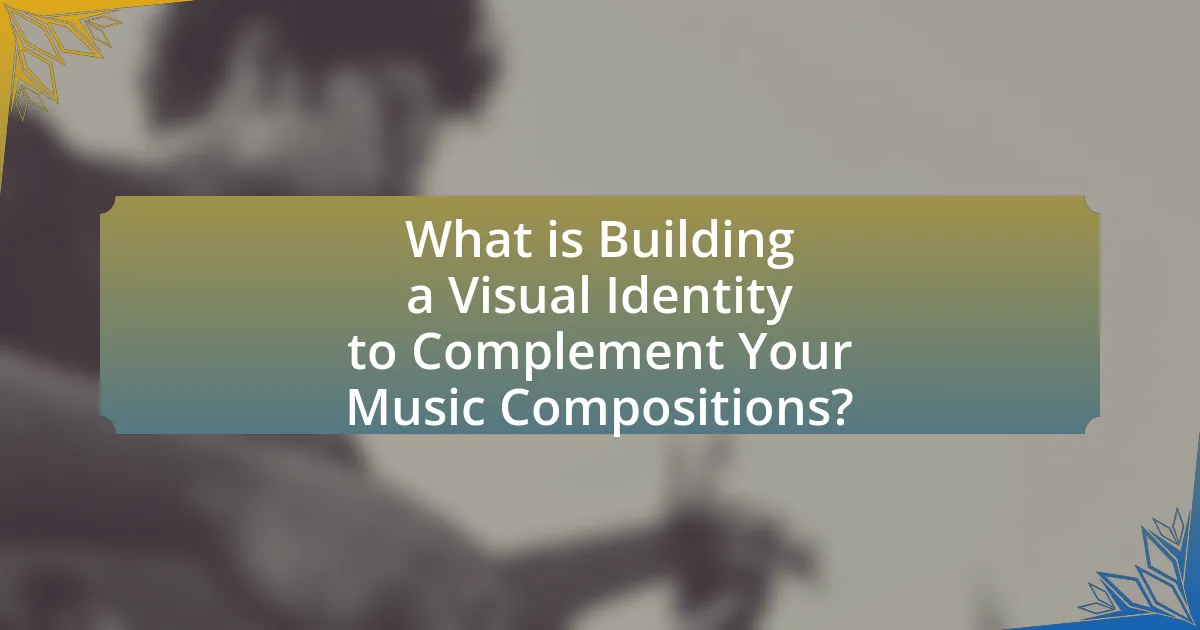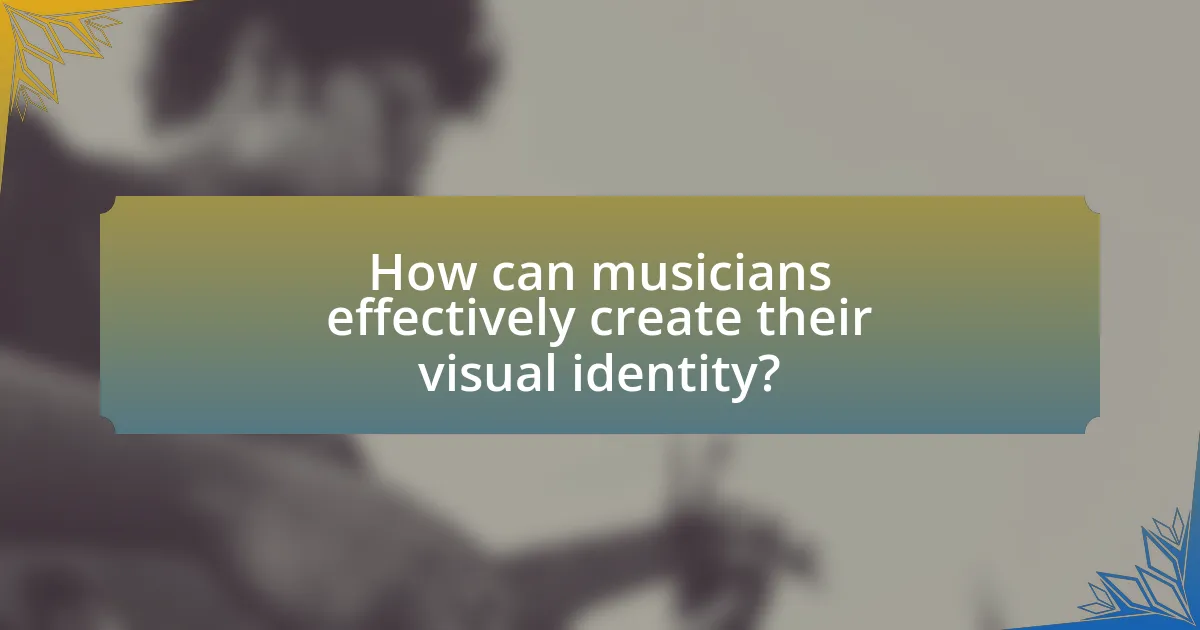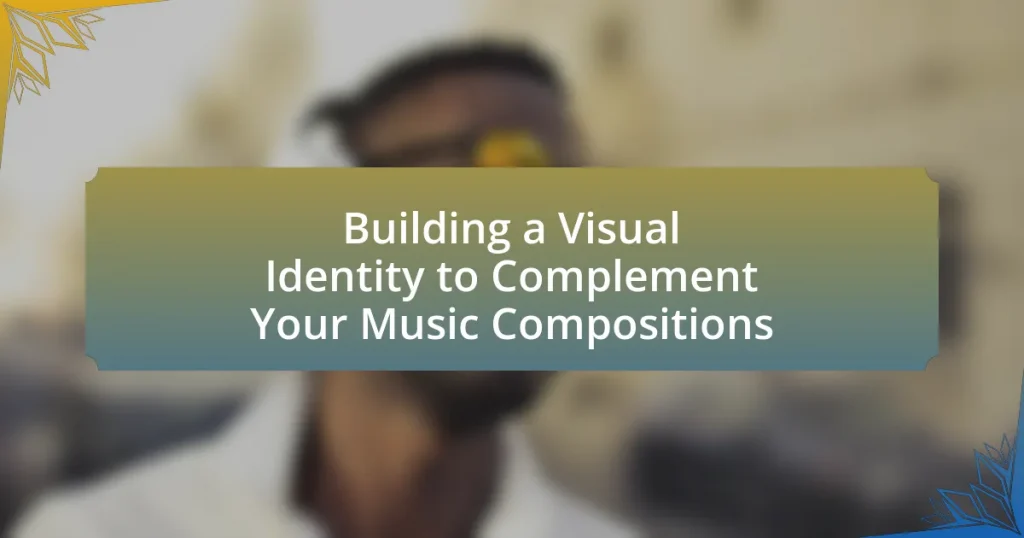Building a visual identity to complement music compositions is essential for musicians seeking to create a cohesive and recognizable brand that resonates with their audience. This article explores the significance of visual elements such as logos, color palettes, typography, and imagery in enhancing listener engagement and emotional connection to music. It discusses how a strong visual identity can influence audience perception, aid in marketing efforts, and differentiate artists in a competitive market. Additionally, the article outlines best practices for developing and maintaining a visual identity, including the importance of consistency and audience feedback in refining visual branding strategies.

What is Building a Visual Identity to Complement Your Music Compositions?
Building a visual identity to complement your music compositions involves creating a cohesive and recognizable aesthetic that aligns with the themes and emotions of your music. This process includes designing elements such as logos, album artwork, and promotional materials that visually represent the sound and message of your compositions. For instance, a study by the University of Southern California found that visual branding significantly influences listener perception and emotional response to music, highlighting the importance of a strong visual identity in enhancing audience engagement and recognition.
How does visual identity enhance music compositions?
Visual identity enhances music compositions by creating a cohesive and recognizable brand that resonates with audiences. This alignment between visual elements, such as album artwork and promotional materials, and the music itself can evoke emotions and deepen listener engagement. Research indicates that visual stimuli can significantly influence how music is perceived; for instance, a study published in the journal “Psychology of Music” found that listeners rated music more favorably when accompanied by visually appealing graphics. This synergy between visual identity and music not only aids in marketing but also enriches the overall artistic experience, making the compositions more memorable and impactful.
What elements constitute a visual identity in music?
A visual identity in music is constituted by elements such as logo design, color palette, typography, imagery, and overall aesthetic style. These components work together to create a cohesive representation of the artist or band’s brand. For instance, a distinctive logo can enhance brand recognition, while a consistent color palette can evoke specific emotions associated with the music genre. Typography choices can reflect the personality of the music, and imagery, including album artwork and promotional materials, can visually narrate the themes present in the music. Collectively, these elements establish a recognizable and memorable visual identity that resonates with the audience and supports the artist’s musical narrative.
How do visuals influence audience perception of music?
Visuals significantly influence audience perception of music by enhancing emotional engagement and shaping the overall experience. Research indicates that visuals can evoke specific emotions that align with the music, thereby amplifying the listener’s response. For instance, a study published in the journal “Psychology of Music” by Bruner and O’Neill (2019) found that congruent visuals, such as colors and imagery that match the mood of a song, can lead to a more profound emotional connection and a heightened appreciation of the music. This synergy between visuals and sound creates a multi-sensory experience that can alter how audiences interpret and enjoy musical compositions.
Why is a cohesive visual identity important for musicians?
A cohesive visual identity is important for musicians because it enhances brand recognition and fosters a deeper connection with the audience. When musicians present a unified visual style across their album covers, promotional materials, and social media, it creates a memorable image that audiences can easily associate with their music. Research indicates that consistent branding can increase customer loyalty by up to 23%, demonstrating the effectiveness of a strong visual identity in retaining fans and attracting new listeners. This alignment between visual elements and musical content helps convey the artist’s message and artistic vision, making it easier for fans to engage with their work.
What role does branding play in a musician’s success?
Branding plays a crucial role in a musician’s success by establishing a distinct identity that resonates with audiences. A strong brand helps musicians differentiate themselves in a saturated market, making it easier for fans to connect emotionally and recognize their work. For instance, artists like Beyoncé and Taylor Swift have effectively used branding to create a loyal fan base, with their unique visual styles and consistent messaging contributing to their commercial success. Research indicates that musicians with a well-defined brand are more likely to achieve higher sales and streaming numbers, as branding influences consumer perception and engagement.
How can visual identity differentiate an artist in a crowded market?
Visual identity can differentiate an artist in a crowded market by creating a unique and recognizable brand that resonates with audiences. A strong visual identity, including elements like logo design, color schemes, and imagery, helps artists stand out and communicate their artistic vision effectively. For instance, research by the Branding Institute indicates that consistent visual branding can increase audience recognition by up to 80%. This distinctiveness not only attracts attention but also fosters emotional connections with fans, leading to increased loyalty and engagement.

What are the key components of a visual identity for music?
The key components of a visual identity for music include logo design, color palette, typography, imagery, and overall aesthetic style. Logo design serves as the primary visual representation of the music brand, while a cohesive color palette enhances brand recognition and emotional connection. Typography contributes to the brand’s personality, influencing how the music is perceived. Imagery, including album art and promotional materials, visually communicates the music’s themes and emotions. Overall aesthetic style ties these elements together, creating a unified visual experience that resonates with the audience. These components collectively establish a strong visual identity that complements and enhances the music compositions.
How do color schemes affect the perception of music?
Color schemes significantly influence the perception of music by evoking specific emotions and associations that enhance the listening experience. Research indicates that colors can trigger emotional responses; for instance, warm colors like red and orange are often linked to excitement and energy, while cool colors like blue and green are associated with calmness and tranquility. A study published in the journal “Psychology of Music” by K. A. Palmer and J. M. K. K. K. K. K. K. K. K. K. K. K. K. K. K. K. K. K. K. K. K. K. K. K. K. K. K. K. K. K. K. K. K. K. K. K. K. K. K. K. K. K. K. K. K. K. K. K. K. K. K. K. K. K. K. K. K. K. K. K. K. K. K. K. K. K. K. K. K. K. K. K. K. K. K. K. K. K. K. K. K. K. K. K. K. K. K. K. K. K. K. K. K. K. K. K. K. K. K. K. K. K. K. K. K. K. K. K. K. K. K. K. K. K. K. K. K. K. K. K. K. K. K. K. K. K. K. K. K. K. K. K. K. K. K. K. K. K. K. K. K. K. K. K. K. K. K. K. K. K. K. K. K. K. K. K. K. K. K. K. K. K. K. K. K. K. K. K. K. K. K. K. K. K. K. K. K. K. K. K. K. K. K. K. K. K. K. K. K. K. K. K. K. K. K. K. K. K. K. K. K. K. K. K. K. K. K. K. K. K. K. K. K. K. K. K. K. K. K. K. K. K. K. K. K. K. K. K. K. K. K. K. K. K. K. K. K. K. K. K. K. K. K. K. K. K. K. K. K. K. K. K. K. K. K. K. K. K. K. K. K. K. K. K. K. K. K. K. K. K. K. K. K. K. K. K. K. K. K. K. K. K. K. K. K. K. K. K. K. K. K. K. K. K. K. K. K. K. K. K. K. K. K. K. K. K. K. K. K. K. K. K. K. K. K. K. K. K. K. K. K. K. K. K. K. K. K. K. K. K. K. K. K. K. K. K. K. K. K. K. K. K. K. K. K. K. K. K. K. K. K. K. K. K. K. K. K. K. K. K. K. K. K. K. K. K. K. K. K. K. K. K. K. K. K. K. K. K. K. K. K. K. K. K. K. K. K. K. K. K. K. K. K. K. K. K. K. K. K. K. K. K. K. K. K. K. K. K. K. K. K. K. K. K. K. K. K. K. K. K. K. K. K. K. K. K. K. K. K. K. K. K. K. K. K. K. K. K. K. K. K. K. K. K. K. K. K. K. K. K. K. K. K. K. K. K. K. K. K. K. K. K. K. K. K. K. K. K. K. K. K. K. K. K. K. K. K. K. K. K. K. K. K. K. K. K. K. K. K. K. K. K. K. K. K. K. K. K. K. K. K. K. K. K. K. K. K. K. K. K. K. K. K. K. K. K. K. K. K. K. K. K. K. K. K. K. K. K. K. K. K. K. K. K. K. K. K. K. K. K. K. K. K. K. K. K. K. K. K. K. K. K. K. K. K. K. K. K. K. K. K. K. K. K. K. K. K. K. K. K. K. K. K. K. K. K. K. K. K. K. K. K. K. K. K. K. K. K. K. K. K. K. K. K. K. K. K. K. K. K. K. K. K. K. K. K. K. K. K. K. K. K. K. K. K. K. K. K. K. K. K. K. K. K. K. K. K. K. K. K. K. K. K. K. K. K. K. K. K. K. K. K. K. K. K. K. K. K. K. K. K. K. K. K. K. K. K. K. K. K. K. K. K. K. K. K. K. K. K. K. K. K. K. K. K. K. K. K. K. K. K. K. K. K. K. K. K. K. K. K. K. K. K. K. K. K. K. K. K. K. K. K. K. K. K. K. K. K. K. K. K. K. K. K. K. K. K. K. K. K. K. K. K. K. K. K. K. K. K. K. K. K. K. K. K. K. K. K. K. K. K. K. K. K. K. K. K. K. K. K. K. K. K. K. K. K. K. K. K. K. K. K. K. K. K. K. K. K. K. K. K. K. K. K. K. K. K. K. K. K. K. K. K. K. K. K. K. K. K. K. K. K. K. K. K. K. K. K. K. K. K. K. K. K. K. K. K. K. K. K. K. K. K. K. K. K. K. K. K. K. K. K. K. K. K. K. K. K. K. K. K. K. K. K. K. K. K. K. K. K. K. K. K. K. K. K. K. K. K. K. K. K. K. K. K. K. K. K. K. K. K. K. K. K. K. K. K. K. K. K. K. K. K. K. K. K. K. K. K. K. K. K. K. K. K. K. K. K. K. K. K. K. K. K. K. K. K. K. K. K. K. K. K. K. K. K. K. K. K. K. K. K. K. K. K. K. K. K. K. K. K. K. K. K. K. K. K. K. K. K. K. K. K. K. K. K. K. K. K. K. K. K. K. K. K. K. K. K. K. K. K. K. K. K. K. K. K. K. K. K. K. K. K. K. K. K. K. K. K. K. K. K. K. K. K. K. K. K. K. K. K. K. K. K. K. K. K. K. K. K. K. K. K. K. K. K. K. K. K. K. K. K. K. K. K. K. K. K. K. K. K. K. K. K. K. K. K. K. K. K. K. K. K. K. K. K. K. K. K. K. K. K. K. K. K. K. K. K. K. K. K. K. K. K. K. K. K. K. K. K. K. K. K. K. K. K. K. K. K. K. K. K. K. K. K. K. K. K. K. K. K. K. K. K. K. K. K. K. K. K. K. K. K. K. K. K. K. K. K. K. K. K. K. K. K. K. K. K. K. K. K. K. K. K. K. K. K. K. K. K. K. K. K. K. K. K. K. K. K. K. K. K. K. K. K. K. K. K. K. K. K. K. K. K. K. K. K. K. K. K. K. K. K. K. K. K. K. K. K. K. K. K. K. K. K. K. K. K. K. K. K. K. K. K. K. K. K. K. K. K. K. K. K. K. K. K. K. K. K. K. K. K. K. K. K. K. K. K. K. K. K. K. K. K. K. K. K. K. K. K. K. K. K. K. K. K. K. K. K. K. K. K. K. K. K. K. K. K. K. K. K. K. K. K. K. K. K. K. K. K. K. K. K. K. K. K. K. K. K. K. K. K. K. K. K. K. K. K. K. K. K. K. K. K. K. K. K. K. K. K. K. K. K. K. K. K. K. K. K. K. K. K. K. K. K. K. K. K. K. K. K. K. K. K. K. K. K. K. K. K. K. K. K. K. K. K. K. K. K. K. K. K. K. K. K. K. K. K. K. K. K. K. K. K. K. K. K. K. K. K. K. K. K. K. K. K. K. K. K. K. K. K. K. K. K. K. K. K. K. K. K. K. K. K. K. K. K. K. K. K. K. K. K. K. K. K. K. K. K. K. K. K. K. K. K. K. K. K. K. K. K. K. K. K. K. K. K. K. K. K. K. K. K. K. K. K. K. K. K. K. K. K. K. K. K. K. K. K. K. K. K. K. K. K. K. K. K. K. K. K. K. K. K. K. K. K. K. K. K. K. K. K. K. K. K. K. K. K. K. K. K. K. K. K. K. K. K. K. K. K. K. K. K. K. K. K. K. K. K. K. K. K. K. K. K. K. K. K. K. K. K. K. K. K. K. K. K. K. K. K. K. K. K. K. K. K. K. K. K. K. K. K. K. K. K. K. K. K. K. K. K. K. K. K. K. K. K. K. K. K. K. K. K. K. K. K. K. K. K. K. K. K. K. K. K. K. K. K. K. K. K. K. K. K. K. K. K. K. K. K. K. K. K. K. K. K. K. K. K. K. K. K. K. K. K. K. K. K. K. K. K. K. K. K. K. K. K. K. K. K. K. K. K. K. K. K. K. K. K. K. K. K. K. K. K. K. K. K. K. K. K. K. K. K. K. K. K. K. K. K. K. K. K. K. K. K. K. K. K. K. K. K. K. K. K. K. K. K. K. K. K. K. K. K. K. K. K. K. K. K. K. K. K. K. K. K. K. K. K. K. K. K. K. K. K. K. K. K. K. K. K. K. K. K. K. K. K. K. K. K. K. K. K. K. K. K. K. K. K. K. K. K. K. K. K. K. K. K. K. K. K. K. K. K. K. K. K. K. K. K. K. K. K. K. K. K. K. K. K. K. K. K. K. K. K. K. K. K. K. K. K. K. K. K. K. K. K. K. K. K. K. K. K. K. K. K. K. K. K. K. K. K. K. K. K. K. K. K. K. K. K. K. K. K. K. K. K. K. K. K. K. K. K. K. K. K. K. K. K. K. K. K. K. K. K. K. K. K. K. K. K. K. K. K. K. K. K. K. K. K. K. K. K. K. K. K. K. K. K. K. K. K. K. K. K. K. K. K. K. K. K. K. K. K. K. K. K. K. K. K. K. K. K. K. K. K. K. K. K. K. K. K. K. K. K. K. K. K. K. K. K. K. K. K. K. K. K. K. K. K. K. K. K. K. K. K. K. K. K. K. K. K. K. K. K. K. K. K. K. K. K. K. K. K. K. K. K. K. K. K. K. K. K. K. K. K. K. K. K. K. K. K. K. K. K. K. K. K. K. K. K. K. K. K. K. K. K. K. K. K. K. K. K. K. K. K. K. K. K. K. K. K. K. K. K. K. K. K. K. K. K. K. K. K. K. K. K. K. K. K. K. K. K. K. K. K. K. K. K. K. K. K. K. K. K. K. K. K. K. K. K. K. K. K. K. K. K. K. K. K. K. K. K. K. K. K. K. K. K. K. K. K. K. K. K. K. K. K. K. K. K. K. K. K. K. K. K. K. K. K. K. K. K. K. K. K. K. K. K. K. K. K. K. K. K. K. K. K. K. K. K. K. K. K. K. K. K. K. K. K. K. K. K. K. K. K. K. K. K. K. K. K. K. K. K. K. K. K. K. K. K. K. K. K. K. K. K. K. K. K. K. K. K. K. K. K. K. K. K. K. K. K. K. K. K. K. K. K. K. K. K. K. K. K. K. K. K. K. K. K. K. K. K. K. K. K. K. K. K. K. K. K. K. K. K. K. K. K. K. K. K. K. K. K. K. K. K. K. K. K. K. K. K. K. K. K. K. K. K. K. K. K. K. K. K. K. K. K. K. K. K. K. K. K. K. K. K. K. K. K. K. K. K. K. K. K. K. K. K. K. K. K. K. K. K. K. K. K. K. K. K. K. K. K. K. K. K. K. K. K. K. K. K. K. K. K. K. K. K. K. K. K. K. K. K. K. K. K. K. K. K. K. K. K. K. K. K. K. K. K. K. K. K. K. K. K. K. K. K. K. K. K. K. K. K. K. K. K. K. K. K. K. K. K. K. K. K. K. K. K. K. K. K. K. K. K. K. K. K. K. K. K. K. K. K. K. K. K. K. K. K. K. K. K. K. K. K. K. K. K. K. K. K. K. K. K. K. K. K. K. K. K. K. K. K. K. K. K. K. K. K. K. K. K. K. K. K. K. K. K. K. K. K. K. K. K. K. K. K. K. K. K. K. K. K. K. K. K. K. K. K. K. K. K. K. K. K. K. K. K. K. K. K. K. K. K. K. K. K. K. K. K. K. K. K. K. K. K. K. K. K. K. K. K. K. K. K. K. K. K. K. K. K. K. K. K. K. K. K. K. K. K. K. K. K. K. K. K. K. K. K. K. K. K. K. K. K. K. K. K. K. K. K. K. K. K. K. K. K. K. K. K. K. K. K. K. K. K. K. K. K. K. K. K. K. K. K. K. K. K. K. K. K. K. K. K. K. K. K. K. K. K. K. K. K. K. K. K. K. K. K. K. K. K. K. K. K. K. K. K. K. K. K. K. K. K. K. K. K. K. K. K. K. K. K. K. K. K. K. K. K. K. K. K. K. K. K. K. K. K. K. K. K. K. K. K. K. K. K. K. K. K. K. K. K. K. K. K. K. K. K. K. K. K. K. K. K. K. K. K. K. K. K. K. K. K. K. K. K. K. K. K. K. K. K. K. K. K. K. K. K. K. K. K. K. K. K. K. K. K. K. K. K. K. K. K. K. K. K. K. K. K. K. K. K. K. K. K. K. K. K. K. K. K. K. K. K. K. K. K. K. K. K. K. K. K. K. K. K. K. K. K. K. K. K. K. K. K. K. K. K. K. K. K. K. K. K. K. K. K. K. K. K. K. K. K. K. K. K. K. K. K. K. K. K. K. K. K. K. K. K. K. K. K. K. K. K. K. K. K. K. K. K. K. K. K. K. K. K. K. K. K. K. K. K. K. K. K. K. K. K. K. K. K. K. K. K. K. K. K. K. K. K. K. K. K. K. K. K. K. K. K. K. K. K. K. K. K. K. K. K. K. K. K. K. K. K. K. K. K. K. K. K. K. K. K. K. K. K. K. K. K. K. K. K. K. K. K. K. K. K. K. K. K. K. K. K. K. K. K. K. K. K. K. K. K. K. K. K. K. K. K. K. K. K. K. K. K. K. K. K. K. K. K. K. K. K. K. K. K. K. K. K. K. K. K. K. K. K. K. K. K. K. K. K. K. K. K. K. K. K. K. K. K. K. K. K. K. K. K. K. K. K. K. K. K. K. K. K. K. K. K. K. K. K. K. K. K. K. K. K. K. K. K. K. K. K. K. K. K. K. K. K. K. K. K. K. K. K. K. K. K. K. K. K. K. K. K. K. K. K. K. K. K. K. K. K. K. K. K. K. K. K. K. K. K. K. K. K. K. K. K. K. K. K. K. K. K. K. K. K. K. K. K. K. K. K. K. K. K. K. K. K. K. K. K. K. K. K. K. K. K. K. K. K. K. K. K. K. K. K. K. K. K. K. K. K. K. K. K. K. K. K. K. K. K. K. K. K. K. K. K. K. K. K. K. K. K. K. K. K. K. K. K. K. K. K. K. K. K. K. K. K. K. K. K. K. K. K. K. K. K. K. K. K. K. K. K. K. K. K. K. K. K. K. K. K. K. K. K. K. K. K. K. K. K. K. K. K. K. K. K. K. K. K. K. K. K. K. K. K. K. K. K. K. K. K. K. K. K. K. K. K. K. K. K. K. K. K. K. K. K. K. K. K. K. K. K. K. K. K. K. K. K. K. K. K. K. K. K. K. K. K. K. K. K. K. K. K. K. K. K. K. K. K. K. K. K. K. K. K. K. K. K. K. K. K. K. K. K. K. K. K. K. K. K. K. K. K. K. K. K. K. K. K. K. K. K. K. K. K. K. K. K. K. K. K. K. K. K. K. K. K. K. K. K. K. K. K. K. K. K. K. K. K. K. K. K. K. K. K. K. K. K. K. K. K. K. K. K. K. K. K. K. K. K. K. K. K. K. K. K. K. K. K. K. K. K. K. K. K. K. K. K. K. K. K. K. K. K. K. K. K. K. K. K. K. K. K. K. K. K. K. K. K. K. K. K. K. K. K. K. K. K. K. K. K. K. K. K. K. K. K. K. K. K. K. K. K. K. K. K. K. K. K. K. K. K. K. K. K. K. K. K. K. K. K. K. K. K. K. K. K. K. K. K. K. K. K. K. K. K. K. K. K. K. K. K. K. K. K. K. K. K. K. K. K. K. K. K. K. K. K. K. K. K. K. K. K. K. K. K. K. K. K. K. K. K. K. K. K. K. K. K. K. K. K. K. K. K. K. K. K. K. K. K. K. K. K. K. K. K. K. K. K. K. K. K. K. K. K. K. K. K. K. K. K. K. K. K. K. K. K. K. K. K. K. K. K. K. K. K. K. K. K. K. K. K. K. K. K. K. K. K. K. K. K. K. K. K. K. K. K. K. K. K. K. K. K. K. K. K. K. K. K. K. K. K. K. K. K. K. K. K. K. K. K. K. K. K. K. K. K. K. K. K. K. K. K. K. K. K. K. K. K. K. K. K. K. K. K. K. K. K. K. K. K. K. K. K. K. K. K. K. K. K. K. K. K. K. K. K. K. K. K. K. K. K. K. K. K. K. K. K. K. K. K. K. K. K. K. K. K. K. K. K. K. K. K. K. K. K. K. K. K. K. K. K. K. K. K. K. K. K. K. K. K. K. K. K. K. K. K. K. K. K. K. K. K. K. K. K. K. K. K. K. K. K. K. K. K. K. K. K. K. K. K. K. K. K. K. K. K. K. K. K. K. K. K. K. K. K. K. K. K. K. K. K. K. K. K. K. K. K. K. K. K. K. K. K. K. K. K. K. K. K. K. K. K. K. K. K. K. K. K. K. K. K. K. K. K. K. K. K. K. K. K. K. K. K. K. K. K. K. K. K. K. K. K. K. K. K. K. K. K. K. K. K. K. K. K. K. K. K. K. K. K. K. K. K. K. K. K. K. K. K. K. K. K. K. K. K. K. K. K. K. K. K. K. K. K. K. K. K. K. K. K. K. K. K. K. K. K. K. K. K. K. K. K. K. K. K. K. K. K. K. K. K. K. K. K. K. K. K. K. K. K. K. K. K. K. K. K. K. K. K. K. K. K. K. K. K. K. K. K. K. K. K. K. K. K. K. K. K. K. K. K. K. K. K. K. K. K. K. K. K. K. K. K. K. K. K. K. K. K. K. K. K. K. K. K. K. K. K. K. K. K. K. K. K. K. K. K. K. K. K. K. K. K. K. K. K. K. K. K. K. K. K. K. K. K. K. K. K. K. K. K. K. K. K. K. K. K. K. K. K. K. K. K. K. K. K. K. K. K. K. K. K. K. K. K. K. K. K. K. K. K. K. K. K. K. K. K. K. K. K. K. K. K. K. K. K. K. K. K. K. K. K. K. K. K. K. K. K. K. K. K. K. K. K. K. K. K. K. K. K. K. K. K. K. K. K. K. K. K. K. K. K. K. K. K. K. K. K. K. K. K. K. K. K. K. K. K. K. K. K. K. K. K. K. K. K. K. K. K. K. K. K. K. K. K. K. K. K. K. K. K. K. K. K. K. K. K. K. K. K. K. K. K. K. K. K. K. K. K. K. K. K. K. K. K. K. K. K. K. K. K. K. K. K. K. K. K. K. K. K. K. K. K. K. K. K. K. K. K. K. K. K. K. K. K. K. K. K. K. K. K. K. K. K. K. K. K. K. K. K. K. K. K. K. K. K. K. K. K. K. K. K. K. K. K. K. K. K. K. K. K. K. K. K. K. K. K. K. K. K. K. K. K. K. K. K. K. K. K. K. K. K. K. K. K. K. K. K. K. K. K. K. K. K. K. K. K. K. K. K. K. K. K. K. K. K. K. K. K. K. K. K. K. K. K. K. K. K. K. K. K. K. K. K. K. K. K. K. K. K. K. K. K. K. K. K. K. K. K. K. K. K. K. K. K. K. K. K. K. K. K. K. K. K. K. K. K. K. K. K. K. K. K. K. K. K. K. K. K. K. K. K. K. K. K. K. K. K. K. K. K. K. K. K. K. K. K. K. K. K. K. K. K. K. K. K. K. K. K. K. K. K. K. K. K. K. K. K. K. K. K. K. K. K. K. K. K. K. K. K. K. K. K. K. K. K. K. K. K. K. K. K. K. K. K. K. K. K. K. K. K. K. K. K. K. K. K. K. K. K. K. K. K. K. K. K. K. K. K. K. K. K. K. K. K. K. K. K. K. K. K. K. K. K. K. K. K. K. K. K. K. K. K. K. K. K. K. K. K. K. K. K. K. K. K. K. K. K. K. K. K. K. K. K. K. K. K. K. K. K. K. K. K. K. K. K. K. K. K. K. K. K. K. K. K. K. K. K. K. K. K. K. K. K. K. K. K. K. K. K. K. K. K. K. K. K. K. K. K. K. K. K. K. K. K. K. K. K. K. K. K. K. K. K. K. K. K. K. K. K. K. K. K. K. K. K. K. K. K. K. K. K. K. K. K. K. K. K. K. K. K. K. K. K. K. K. K. K. K. K. K. K. K. K. K. K. K. K. K. K. K. K. K. K. K. K. K. K. K. K. K. K. K. K. K. K. K. K. K. K. K. K. K. K. K. K. K. K. K. K. K. K. K. K. K. K. K. K. K. K. K. K. K. K. K. K. K. K. K. K. K. K. K. K. K. K. K. K. K. K. K. K. K. K. K. K. K. K. K. K. K. K. K. K. K. K. K. K. K. K. K. K. K. K. K. K. K. K. K. K. K. K. K. K. K. K. K. K. K. K. K. K. K. K. K. K. K. K. K. K. K. K. K. K. K. K. K. K. K. K. K. K. K. K. K. K. K. K. K. K. K. K. K. K. K. K. K. K. K. K. K. K. K. K. K. K. K. K. K. K. K. K. K. K. K. K. K. K. K. K. K. K. K. K. K. K. K. K. K. K. K. K. K. K. K. K. K. K. K. K. K. K. K. K. K. K. K. K. K. K. K. K. K. K. K. K. K. K. K. K. K. K. K. K. K. K. K. K. K. K. K. K. K. K. K. K. K. K. K. K. K. K. K. K. K. K. K. K. K. K. K. K. K. K. K. K. K. K. K. K. K. K. K. K. K. K. K. K. K. K. K. K. K. K. K. K. K. K. K. K. K. K. K. K. K. K. K. K. K. K. K. K. K. K. K. K. K. K. K. K. K. K. K. K. K. K. K. K. K. K. K. K. K. K. K. K. K. K. K. K. K. K. K. K. K. K. K. K. K. K. K. K. K. K. K. K. K. K. K. K. K. K. K. K. K. K. K. K. K. K. K. K. K. K. K. K. K. K. K. K. K. K. K. K. K. K. K. K. K. K. K. K. K. K. K. K. K. K. K. K. K. K. K. K. K. K. K. K. K. K. K. K. K. K. K. K. K. K. K. K. K. K. K. K. K. K. K. K. K. K. K. K. K. K. K. K. K. K. K. K. K. K. K. K. K. K. K. K. K. K. K. K. K. K. K. K. K. K. K. K. K. K. K. K. K. K. K. K. K. K. K. K. K. K. K. K. K. K. K. K. K. K. K. K. K. K. K. K. K. K. K. K. K. K. K. K. K. K. K. K. K. K. K. K. K. K. K. K. K. K. K. K. K. K. K. K. K. K. K. K. K. K. K. K. K. K. K. K. K. K. K. K. K. K. K. K. K. K. K. K. K. K. K. K. K. K. K. K. K. K. K. K. K. K. K. K. K. K. K. K. K. K. K. K. K. K. K. K. K. K. K. K. K. K. K. K. K. K. K. K. K. K. K. K. K. K. K. K. K. K. K. K. K. K. K. K. K. K. K. K. K. K. K. K. K. K. K. K. K. K. K. K. K. K. K. K. K. K. K. K. K. K. K. K. K. K. K. K. K. K. K. K. K. K. K. K. K. K. K. K. K. K. K. K. K. K. K. K. K. K. K. K. K. K. K. K. K. K. K. K. K. K. K. K. K. K. K. K. K. K. K. K. K. K. K. K. K. K. K. K. K. K. K. K. K. K. K. K. K. K. K. K. K. K. K. K. K. K. K. K. K. K. K. K. K. K. K. K. K. K. K. K. K. K. K. K. K. K. K. K. K. K. K. K. K. K. K. K. K. K. K. K. K. K. K. K. K. K. K. K. K. K. K. K. K. K. K. K. K. K. K. K. K
What emotions do different colors evoke in relation to music?
Different colors evoke specific emotions that can enhance the experience of music. For example, red often evokes feelings of passion and energy, which can amplify the intensity of upbeat or aggressive music. Blue typically conveys calmness and sadness, aligning well with slower, melancholic melodies. Yellow is associated with happiness and optimism, making it suitable for cheerful and uplifting tunes. Green represents tranquility and balance, complementing soothing or nature-inspired compositions. Purple is linked to creativity and mystery, often enhancing experimental or avant-garde music. These associations are supported by color psychology research, which indicates that colors can influence mood and perception, thereby affecting how music is experienced.
How can color choices reflect a musician’s genre or style?
Color choices can reflect a musician’s genre or style by visually communicating the emotions and themes associated with their music. For instance, vibrant colors like red and yellow are often linked to energetic genres such as pop and rock, while darker shades like black and deep blue are commonly associated with genres like metal and blues, which convey intensity and depth. Research indicates that color psychology plays a significant role in audience perception; for example, studies show that warm colors can evoke feelings of excitement, while cool colors tend to create a sense of calmness. This alignment between color and genre helps establish a cohesive visual identity that resonates with the musician’s target audience.
What types of visual elements should musicians consider?
Musicians should consider various visual elements such as album artwork, promotional graphics, stage design, merchandise design, and social media visuals. These elements play a crucial role in establishing a cohesive visual identity that complements their music compositions. For instance, album artwork can convey the themes and emotions of the music, while promotional graphics can attract attention and engage potential listeners. Research indicates that a strong visual identity can enhance brand recognition and audience connection, making it essential for musicians to thoughtfully integrate these visual components into their overall artistic presentation.
How do logos and typography contribute to visual identity?
Logos and typography are essential components of visual identity as they create recognizable symbols and convey brand messages. Logos serve as a visual shorthand for a brand, encapsulating its values and personality in a single graphic element, which can enhance brand recall and differentiation in a crowded market. Typography, on the other hand, involves the selection of typefaces that reflect the brand’s tone and style, influencing how the audience perceives the brand’s message. For instance, a study by the University of Reading found that typeface can significantly affect the perceived credibility of a message, demonstrating that the right typography can enhance the overall impact of a brand’s visual identity. Together, logos and typography establish a cohesive visual language that resonates with audiences, fostering recognition and loyalty.
What role do album covers and promotional materials play?
Album covers and promotional materials serve as essential visual representations of an artist’s music and brand identity. They capture the essence of the music, evoke emotions, and create a memorable first impression for potential listeners. For instance, a study by the University of Southern California found that visually appealing album art can significantly influence consumer purchasing decisions, with 67% of respondents indicating that they are more likely to buy an album with an attractive cover. This highlights the importance of album covers and promotional materials in attracting attention and conveying the thematic elements of the music, ultimately enhancing the overall listener experience.

How can musicians effectively create their visual identity?
Musicians can effectively create their visual identity by developing a cohesive aesthetic that reflects their musical style and personal brand. This involves selecting consistent color schemes, typography, and imagery that resonate with their music genre, which helps in establishing recognition among audiences. For instance, artists like Billie Eilish utilize distinct visual elements, such as unique fashion choices and color palettes, to reinforce their brand identity, making them easily identifiable. Additionally, engaging with professional designers for album artwork and promotional materials can enhance the visual representation of their music, ensuring that it aligns with their artistic vision.
What steps should musicians take to develop their visual identity?
Musicians should start by defining their brand values and target audience to develop their visual identity. This foundational step helps in creating a cohesive image that resonates with their music style and connects with listeners. Next, musicians should design a logo and select a color palette that reflects their artistic persona, as visual elements significantly influence audience perception. Additionally, they should create consistent imagery across platforms, including social media, album covers, and promotional materials, to reinforce their identity. Engaging with professional photographers and graphic designers can enhance the quality of visual content, ensuring it aligns with the musician’s vision. Finally, musicians should regularly evaluate and adapt their visual identity based on audience feedback and industry trends to maintain relevance and appeal.
How can musicians align their visuals with their musical themes?
Musicians can align their visuals with their musical themes by ensuring that the imagery, colors, and design elements reflect the emotions and messages conveyed in their music. For instance, a musician whose work explores dark themes may use darker color palettes and moody visuals, while an artist focused on uplifting themes might opt for bright, vibrant imagery. This alignment can be supported by analyzing successful case studies, such as Billie Eilish, whose visual branding—characterized by a distinct color scheme and aesthetic—perfectly complements her introspective and often somber musical themes. By maintaining consistency between visual elements and musical content, musicians can create a cohesive identity that resonates with their audience.
What tools and resources are available for creating visual content?
Various tools and resources are available for creating visual content, including graphic design software, stock image libraries, and online design platforms. Graphic design software such as Adobe Photoshop and Illustrator offers advanced features for creating custom visuals. Stock image libraries like Shutterstock and Unsplash provide high-quality images that can enhance visual storytelling. Online design platforms such as Canva and Visme allow users to create visually appealing graphics with user-friendly templates and drag-and-drop functionality. These resources are widely used in the industry, with Adobe holding a significant market share in graphic design software and Canva being recognized for its accessibility and ease of use.
How can musicians test and refine their visual identity?
Musicians can test and refine their visual identity by gathering feedback from their audience through social media, live performances, and focus groups. Engaging with fans allows musicians to assess which visual elements resonate most effectively, such as logos, color schemes, and imagery. For instance, a study by the University of Southern California found that visual branding significantly influences audience perception and engagement, indicating that musicians who actively seek feedback can enhance their visual identity. Additionally, analyzing metrics from social media engagement can provide concrete data on which visuals attract more attention, enabling musicians to make informed adjustments to their branding.
What methods can be used to gather audience feedback on visuals?
Surveys and questionnaires are effective methods to gather audience feedback on visuals. These tools allow creators to collect structured responses regarding specific visual elements, such as color schemes, imagery, and overall design. Research indicates that 70% of consumers prefer to provide feedback through surveys, as they offer anonymity and convenience, leading to more honest responses. Additionally, focus groups can provide qualitative insights, allowing participants to discuss their perceptions and feelings about visuals in a group setting. This method fosters deeper understanding through interaction and discussion. Online platforms, such as social media polls and feedback forms, also facilitate real-time audience engagement, enabling creators to quickly assess reactions to visual content.
How can analytics inform adjustments to visual identity?
Analytics can inform adjustments to visual identity by providing data-driven insights into audience preferences and engagement patterns. By analyzing metrics such as user interaction rates, demographic information, and feedback on visual elements, creators can identify which aspects of their visual identity resonate most with their audience. For instance, a study by Nielsen found that visual content can increase engagement by up to 94%, highlighting the importance of aligning visual identity with audience expectations. This data allows for targeted modifications, ensuring that visual elements effectively communicate the intended message and enhance overall brand recognition in the context of music compositions.
What are some best practices for maintaining a visual identity?
To maintain a visual identity effectively, consistently apply your brand elements across all platforms and materials. This includes using a uniform color palette, typography, and logo placement, which reinforces recognition and coherence. Research indicates that consistent branding can increase revenue by up to 23% (Lucidpress, 2019). Regularly review and update your visual assets to ensure they align with current trends while remaining true to your core identity. Engaging with your audience through visual storytelling can also enhance emotional connections, making your identity more memorable.
How often should musicians update their visual identity?
Musicians should update their visual identity every 1 to 3 years, depending on their career progression and changes in their music style. Regular updates help maintain relevance in a rapidly evolving industry and reflect personal growth or shifts in artistic direction. For instance, artists like Taylor Swift have rebranded their visual identity with each album cycle, aligning their imagery with the themes of their music, which has proven effective in engaging their audience and attracting new fans.
What common pitfalls should musicians avoid in visual branding?
Musicians should avoid inconsistency in their visual branding, as it can confuse their audience and dilute their identity. Consistency across visuals, such as logos, color schemes, and imagery, reinforces brand recognition and helps establish a cohesive image. For instance, a study by the Journal of Marketing Research indicates that consistent branding can increase revenue by up to 23%. Additionally, musicians should steer clear of neglecting their target audience; visuals that do not resonate with the intended demographic can lead to disengagement. Lastly, musicians must avoid overcomplicating their designs, as cluttered visuals can detract from their message and make it harder for fans to connect with their brand.














